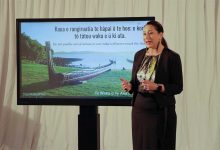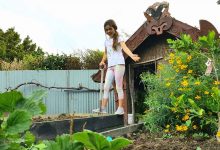Real-time reporting: revisiting and rethinking
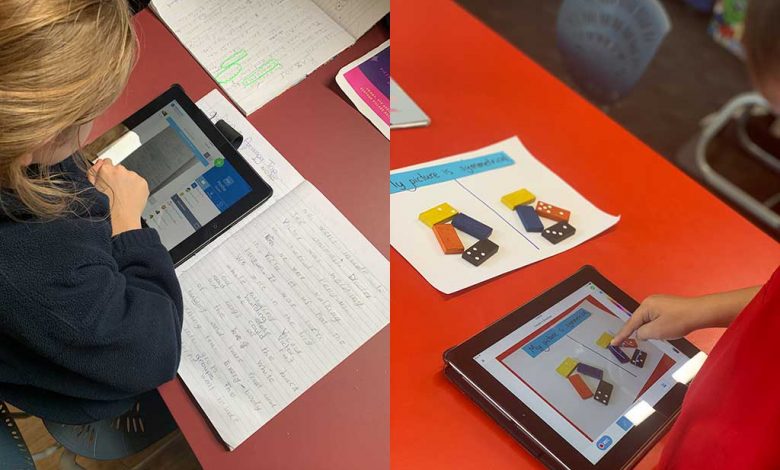
CORE Education’s Ten Trends for 2020 are viewed through five themes – structural, economic, cultural, process, and technology – and the impact they have on the decisions we make in our education settings. In this blog I am going to look at one of the trends explored, real-time reporting, and how we can apply this in practical ways to our mahi as educators.
Real-time reporting has been gaining more and more interest over time. In some educational settings the process change from a traditional twice-a-year report to reporting in real time has either started or is well underway.
Culture is impacted by beliefs, values, attitudes and most importantly relationships.
These define the learning experiences we provide for everyone participating (educators, learners, family/whānau and community). Connecting with our cultural stories is a powerful enabler. It underpins our sense of belonging, and situates us in local, national and global contexts.
“Culturally locating your educational setting is pivotal in creating a culturally responsive curriculum that resonates with the aspirations of mana whenua, whānau and their tamariki. No matter the setting, one common theme reverberates – a sense of belonging, identity, language and culture are at the heart of Māori student success as well as success for all learners.” – Cultural narratives, Ten Trends 2019
What does this look like in a practical sense for real-time reporting?
Significant influences | Practical application |
|---|---|
Shift in ownership
| Alischa Little, eLearning Leader and teacher from Westmere School (Whanganui) shares “In the beginning it was hard for teachers to give full autonomy to children. It was hard to let go of the reins as such. Once the children were scaffolded over a short time we found even our five-year-olds really took control. Right from our new entrant class, students are able to use the Seesaw tools independently. They love posting what they feel is important to them and they have learnt over time that it is all about the process and not about the end product.” Student voice from Westmere School about real-time reporting: “It’s fun to show my Mum and Dad what I am learning”. (Aged 5) “I get to share what I want to share and Mum can send me messages about how hard I worked”. (Aged 5) “My family can get involved with what I am learning about. They can also see when I’m finding my maths hard. They can see on Seesaw and help me at home. They don’t have to wait until the end of the term to see that I might be struggling”. (Aged 11) Phil Walker, Principal at Westmere School (Whanganui) shares “Teachers ‘getting out of the way’ remains a work in progress. It is hard to change from being in control as was the ‘norm’ and now we are asking teachers to move over and support students to take responsibility and accountability for their own learning. I believe students right through the school enjoy posting and sharing their work and progress being made. Teachers sometimes are wanting a ‘finished article’ shared rather than celebrating the ‘work in progress’ and the process being used.” |
Diversity
| There are a few really great platforms now to choose what your school can use effectively for real-time reporting. It’s about choosing what aligns with your vision and which device and platform are accessible for all (students and parents/whānau in particular) A school I was recently working with uses the LINC-ED platform across their Yr 1-6 school. A shift to move towards students driving the learning pathway posts was developing. One thing that was noticeable was the platform wasn’t user friendly for younger students. Students had difficulty logging in independently and the process for uploading images and learning artefacts was clunky. There was a gap in inclusion for these students and this didn’t align with part of the school’s vision around empowering students. The junior syndicate leader started trialling another platform (Seesaw) and gathered enough evidence for the rest of the syndicate to adopt this approach. The teachers all came together, developed their own capabilities to feel more confident to build digital literacies with their students so all students could be empowered to post and share their own learning. |
Digital
| Integrating digital citizenship, formative feedback and literacy. This is to provide a shared writing experience and was particularly effective in a Year 1 class. The teacher shares a learning post with the class or smaller group. The purpose is to demonstrate how we respond in positively constructive ways online. This is an important skill for learners to understand and develop especially when we consider as they grow older this might support cyber-safety in social media contexts. |
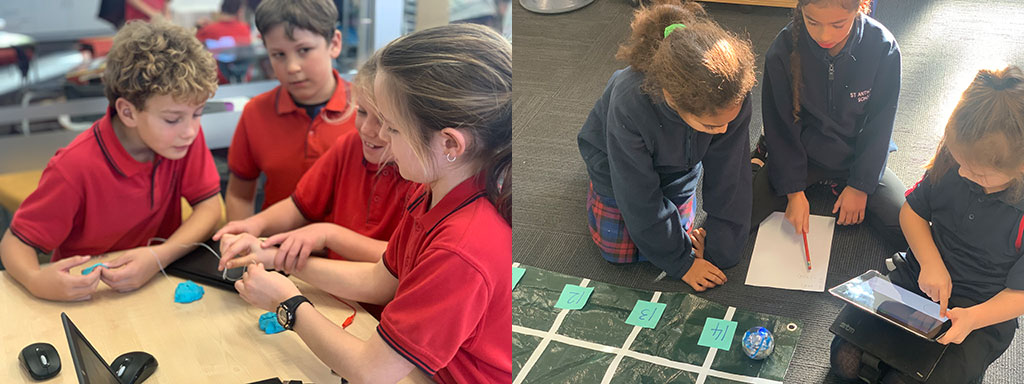
Process Theme
Process is about the way we do things. Having healthy systems and processes in place will ensure that real-time reporting avoids creating frustration, anxiety and tension, and enables the changes to roles and approaches that real-time reporting brings.
Good processes allow us to consider students’ journey through their learning pathways and how we record and report on progress and achievement. We’ll need to focus on planning for up-to-date information to parents/caregivers/whānau and other teachers on a child’s progress, without having to wait for the twice yearly reports and how all this information travels with them. We also need to be mindful to constantly evaluate and examine our ways of doing, being, and knowing, especially to reduce the administrative workload around reporting.
Changes to reporting need to match pedagogical shifts. For example, one of the principles of effective reporting and information sharing is around the move to using digital technologies that enable parents and whānau to see their child’s progress on-line in real time.
What does this look like in a practical sense for real-time reporting?
Significant influences | Practical application |
|---|---|
A maturing of Kāhui Ako/ clusters
| One of the goals for the North Porirua Kāhui Ako (NPKA) digital technologies PLD is to strengthen relationships and sharing of practice across the Kāhui Ako. As part of the PLD journey, teachers across NPKA have come together for various workshops focused on digital technologies. A popular topic that has come up is real-time reporting. Teachers have started to share what their school is doing and schools that are interested in this are hearing their stories. The Kāhui Ako has been responsive to this and has now decided to create a PLD pathway for NPKA focused on real-time reporting. Another consideration in this space is taking a look at what happens in Early Years educational settings. The use of platforms like Educa and StoryPark have been used for some time. When students transition into primary education is there a continuation of learning stories that parents/whānau are connected to? |
Changes to approach in assessment
| Schools like Ormiston Junior College have shown the value of elements of gamification, while linking closely to best practice in learning to use micro-credentialing for personalised assessment. Another example of changing the approach to assessment comes from Westmere School in Whanganui. Alischa Little shares how the evidence of learning is collected and verified. “All student Seesaw journals are monitored by the classroom teacher, our e-learning leader, and the school principal. As a staff we have devised a set of guidelines to ensure student posts cover all of the curriculum areas. Teachers comment on posts and curriculum expectation comments are made twice yearly.” Real-time reporting allows formative and narrative assessment also known as learning stories. They allow teachers and students to fully capture the process within a learning journey. Alischa also shares, “You need to take some time to build some form of professional understanding and capability with Seesaw.” If you are using a platform it is important it aligns with the shift in pedagogical practice. Take the time to understand what the platform can do and it does what you need it to do. It is important to build assessment capabilities with students. They need to have ownership of their learning posts to articulate their thinking and what they are saying about their learning. |
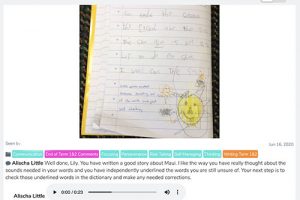 This learning post (from a Year 1 student) shows tags to track and monitor the learning against
This learning post (from a Year 1 student) shows tags to track and monitor the learning against
- Curriculum (writing)
- The school’s growth mindset competencies
- End of Term 1 comment
The teacher has made a comment that links well to the tags. The student has recorded a reflection responding to the feedback.
– Shared by Alischa Little (Westmere School).
Structural Theme
As I noted in the cultural theme, creating an environment where learners feel they belong and can learn is key to how we design learning experiences that meet students’ needs.
“We cannot continue with structures that privilege some, while alienating others and making it more difficult for them to succeed. The issue of systemic inequity cannot be addressed without taking a critical look at the very structures that are contributing to that inequity in the first place.” – Structural Theme, Ten Trends 2020
Within this theme we need to consider whether our real-time reporting structures put learners right in the centre of learning, recognise the importance of relationships, and value the variability, diversity, and identity of learners.
What does this look like in a practical sense for real-time reporting?
Significant influences | Practical application |
|---|---|
A focus on learner and whānau
| Westmere School in Whanganui has collected feedback from parents specifically around their user experience of Seesaw and how well informed they felt about the progress and achievement of their child.
Some schools I have worked with find connecting parents and whānau, and getting engagement can at times be a challenge. Students are the biggest advocates in this situation. If they have started the posting process, they need an audience. Get the students to invite the parents and whānau through something more personalised (handmade invitation for example that include the instructions to connect). If the students have learning posts and they have more ownership over the audience this will create excitement for them. Celebrating the process and not so much the product is also not something that comes naturally to society, we are just not geared that way, so again this needs to be worked on and we need to continue to sell the WHY”. |
Redefining curriculum and assessment
| 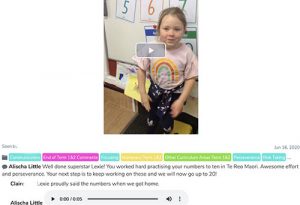 In this Year 1 learning post (shared by Alischa Little, Westmere School) you can see the school tracks growth mindset competencies (communication, focusing, perseverance and risk taking) |
Expanding the concept of school
| The impact of COVID19 and lockdown for Aotearoa has had an impact on what teachers, students and parents know is possible with online and virtual learning. Some schools still produced their mid-term reports, while other schools that have adopted real-time reporting approaches had no need to do this. |
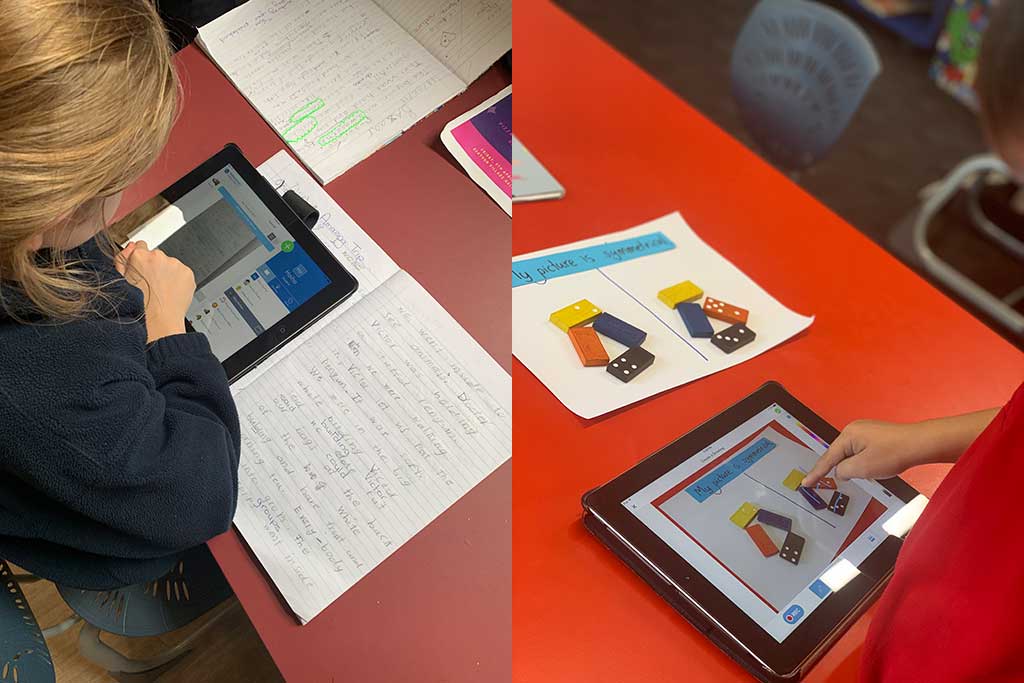
Technology Theme
We live in a time where the pace of change is driven by new technologies and technological advancements. This is having a huge impact on learning and what we experience in our educational settings. There is a range of drivers to consider within this theme; digital literacy and citizenship, curriculum support, personalised learning, accessibility and improving efficacy.
What does this look like in a practical sense for real-time reporting?
Significant influences | Practical application |
|---|---|
Personalised
| Empowering learners.
|
Ubiquitous
| Setting up a real-time learning culture in your educational setting is important.
|
Intelligent
| What sort of functionalities does the platform you’re using for real-time reporting allow to extract and track information? For example AI can be used to ‘data-mine’ a cohort’s results, or an individual’s, to determine common areas requiring additional or explicit teaching. AI can also be used to power the school’s curriculum within a platform. |
Interoperability
| Something to consider with real-time reporting is the learning journey of the student and the ability for the platform used to share or exchange with another. Also if the learning journey travels with the student. Some schools use different tools and platforms for different purposes. For example, LINC-ED is used as a teacher-driven tool to gather progress and achievement data and Seesaw is used as the student-driven tool. Links from Seesaw learning posts can be shared within LINC-ED. Another example is Google integration within Seesaw. |
Sustainability
| We need to consider the key drivers for real-time reporting. Ten Trends 2019 identifies societal influences when it comes to real-time reporting:
What platform or tool is going to best align with the values of your educational setting for you to deliver real-time reporting? Think about what you need as the outcome and what will do this for you. |
Economic Theme
The Economic Theme in Ten Trends 2020 reminds us about the importance of preparing young people to contribute to society and the growth of the economy. We also need to consider within this theme the investment in education. To bring us back to our focus here with real-time reporting, it’s about considering the investment in curriculum and technological resources.
What does this look like in a practical sense for real-time reporting?
Significant influences | Practical application |
|---|---|
| Preparing learners with the skills and knowledge required to take their place in the future workforce | This point links closely back to the competencies we need as drivers within our curriculum delivery. The learning post below is an example from a Year 5 student from St Anthony’s School- Seatoun (teacher Francesca Von Lanthen). The school has been on a journey to develop their digital fluency and knowledge and understanding of the digital technologies (Technology Curriculum learning areas). They needed to find equipment that was affordable, durable and could extend the learning experiences and interests for students learning. The micro:bit fitted the criteria and students are now exploring and creating more solutions and possibilities with learning provocations. The learning post below is an example of a student posting about this learning, the tags the teacher has used to track and monitor learning and teacher feedback. 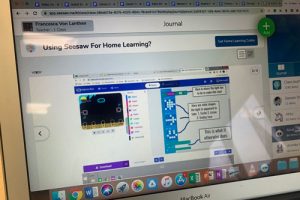 |
| Impact of technology | 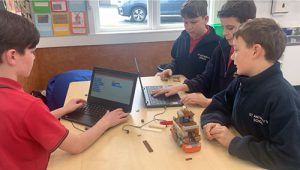 In this photo a group of students collaborate to create their own desired outcome. The students were given exploration time with Edison robots in pairs. The group started discussing and wondered if they could connect two Edison robots together with lego and what the programming code would need to look like to perform their predetermined path. The impact of technology in this situation encouraged collaboration, communication, critical thinking and problem solving. It was fascinating to see this unfold at the time. |
Reflections on lessons learned
Alischa Little shares lessons learned from Westmere School’s real-time reporting journey.
A big lesson in real-time reporting is that you have to let go. We want students to be more responsible for their learning. It has been hard to let go and allow students more freedom and ownership over what they post, when they post it and how they are going to share it (what tool they will use).
Real-time reporting has allowed for a more on-demand approach to sharing with whānau. It has also allowed for full-time working parents to be more engaged in their child’s education. Student data is accessible and understandable for families.It’s a fantastic way for families overseas and around Aotearoa to stay in contact and stay up-to-date with student learning.
I find the real-time reporting is ongoing, so there isn’t the rush at the end of the term to write reports. It enables parents and whānau to see their child’s progress on-line in real-time. The process is driven by our students with appropriate scaffolding by their classroom teachers. The learners decide what to share with the people who are significant to them. The children in our school just love it!







